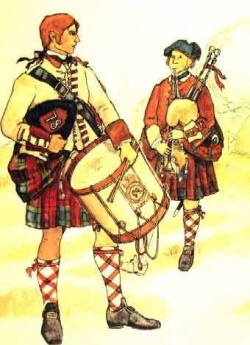1794 invasion scare
A drummer and piper of the Seaforth Regiment which formed part of the defence of the Channel Islands againgst French invasion in 1794
|
During the course of some recent research work, Major G Goold Walker, secretary to the Honourable Artillery Company, came across a number of press references to this Island. No commentary is needed on those which are printed below, for they speak for themselves and record in uncensored language the rise, growth and death of a remarkable war scare.
Daily exercises
The corps of Emigrants, amounting to 750, are daily exercised on the sands between St Hellier and St Aubin. The whole Island exhibits a martial appearance, and no apprehensions are entertained of another attack. Provisions are now enormously high in this island.
The Star 20 January 1794
French vessels sighted
Jersey. Although more exposed than at any other period since the beginning of the war, we have not a single frigate stationed here for the protection of our trade. We have frequently had the mortification to see numbers of vessels in the track from St Maloes to Cherbourg, with an insignificant sloop or frigate. On the 28th, 29th, and 30th of December, above 40 were constantly in sight: the frigate came so near Mount Orgueil Castle, that Captain Lows, who commanded there, ordered the batteries to be manned, to fire at her.
The Carmagnole, a French frigate of 36 guns, that has taken many privateers from this island, has been cruising between Jersey and Cancalle Bay these two months: she carries her confidence so far, as to take a frequent peep into our roads.
The States of the Island have applied for a small squadron, which might not only clear the French coast of these daring adventurers, but give spirit to our privateers and security to our trade. Four or five frigates in Boulay Bay would distress the enemy, by preventing the cabotage from one port to another. Our applications have hitherto been unsuccessful. In the last war, though we had enemies in every part of the world, we were constantly protected.
A Captain Le Feuvre, just returned from La Rochelle, where he had been a prisoner nine months, gives a most miserable picture of that country: He says that incredible numbers of the Royalists have been cut to pieces; that at Noirmoutier the patriots massacred men, women, and children in cold blood; that they arc as much enraged against the English as against the Aristocrates; that from that place to St Maloes the coast is lined with troops, that were drilled for three months twice a day, and then sent to the armies.
Heaven grant that these calamities may not approach nearer to us! Every honest heart must unite in wishes and co-operation for the re-establishment of order, and for a renewal of those social bonds, which endear man to man, and constitute the happiness of life.
The Star 12 February 1794
Jersey was first target
Intelligence is received that the French have for the present changed their intentions of visiting Great Britain, first intending the conquest of the Island of Jersey. The force is collected at St Maloes: the number announced is 10,000 men. The force at Jersey consists of the 63rd regiment, which is 600 strong; about 800 French Royalists in British pay; five companies of invalids; and about 4000 militia."
The Star 15 March 1794
Despatches received
There seems now little doubt that the French will soon attempt a descent upon the islands of Jersey and Guernsey. Early this morning despatches were received by Government from Lord Balcarrass, the Governor, which were brought over express by the Conway lugger, Captain Chabot, which left Jersey on Monday last, and arrived at Plymouth the day before yesterday, about 11 o'clock in the morning.
The Conway is one of the advice boats belonging to the Island, and the master reports that on Sunday morning last at seven o'clock, he was close in with the French shore: that he saw in Granville Bay, at anchor, an immense number of transport and other vessels; that he endeavoured to count them, but found it impossible, they were so numerous, and moored so close to each other - to use the Master's expression, there was literally a cloud of them; he advanced so near the fleet, that a lugger of 12 guns was dispatched in chace of him, which pursued, until he was within three miles of the Island of Guernsey, and had gained on him so much, as to be then within shot, and would have taken him, had he not sought shelter under the guns of one of the forts on the Island; the French lugger then hove about, and stood towards Granville Bay again.
The master further says, that Lord Balcarras was in possession of certain information of the intentions of the French, which he obtains from the emigrants residing at Jersey, many of whom are employed in spy boats, that at all opportunities run close in with the French shore, where they have communicated with their friends, by which means they discover the movements of the enemy. The last boat was over on Saturday evening, at which time 12,000 troops were actually embarked, and some thousands more were then embarking; that they were marching troops to Granville, from all parts of the neighbouring coast, for the expedition against the Islands; and that in Concale Bay there were at anchor six sail of the line, besides a number of heavy frigates, which are intended to cover the landing of the troops.
Most of the frigates in Cancale and Granville Bays have been large two-decked ships cut down, on board each of which are mounted 44 pieces of very heavy cannon on the main deck.
The master says that the inhabitants of Jersey are very much alarmed, but that the Island is in a good state of defence, and that the French will meet a very warm reception; he left the Island with orders to make the first port in the Channel - the wind being in the east, he could not fetch to windward of Plymouth.
The Star 27 March 1794
Invasion force assembles at Chausey
Capt Bennet, of the Rover packet, from Jersey, arrived at Weymouth on Thursday morning, having landed the mail at Teignmouth. He left Jersey late on Monday evening, when Lord Balcarras had received certain information that the French have already established a large part of their force, lately assembled on the coast about St Maloes and Cancale Bay; and a few days since they landed 18,000 men on the Island of Chausey, which lies about half way between St Maloes and Jersey. They were transported thither in 130 boats, under the escort of six sail of the line, besides frigates, and two large ships cut down to serve as batteries, and cover their landing. They came from Cancale.
Captain Bennet brought from Jersey a cargo of passengers, women and children with their valuables. They were informed at Jersey that the attack would have been sooner made, but that the first in command had been poisoned by the second; the second was under arrest, and the third was obliged to go to Paris for orders.
Captain Bennet saw nothing of Admiral MacBride. Captain Saumarez was there, who sailed immediately to reconnoitre.
The Star 30 March 1794
Yesterday an Officer arrived at the War Office with dispatches from the Earl of Balcarras, acting Governor of Jersey, the purport of which being made known to Lord Amherst. His Lordship immediately went to Buckingham House and informed His Majesty of the account that had been received.
In our paper of Saturday we stated that the French had landed 18,000 troops on the island of Chausé, which lies about eight leagues from St Malo, six leagues from Granville, and six from Jersey. The official accounts received on Saturday make this force amount to 20,000 men. There are three or four sail of the line and three French frigates lying in Cancale Bay, besides three more frigates cruising off Chausé.
Lord Balcarras, the Commander in Chief at Jersey, thought the accounts exaggerated: he, however, had sent urgent dispatches to Portsmouth and Plymouth, for naval assistance.
On Monday the transports, with the Third Regiment on board, reached Jersey, and on the following day they were to land. That reinforcement would make, including Invalids, Emigrants, and Militia, the whole military force in Jersey 7,000 men.
The first battalion of Seaforth's corps (the 78th), was still on board transports in Guernsey Road, but was to be landed on Wednesday or Thursday last - In short, every measure was taking that could possibly tend to a respectable defence against the great force that seemed to be coming against them. The force at Guernsey consists of the 78th and 80th regiments, five companies of Invalids, some Artillery, and the Militia of the Island; making in all 5,000 men.
By letters from Guernsey, dated the 25th instant, in the evening, we find that expresses had been sent off to Admiral MacBride, acquainting him with the news. The Admiral was cruising round that Island, and has four 74 gun ships, and six frigates. under his command, Sir James Saumarez, who was lying in Guernsey Road when the above intelligence was received, sailed on the everting of the 25th to Cancale Bay, in his frigate the Crescent, accompanied by the Echo sloop.
The Star 31 March 1794
Watch continues
Plymouth, 30 March: This morning arrived the brigantine Plymouth Packet, of this port, Capt Brown, from Guernsey: she sailed from thence on the 28th instant, at which time no attempt had been made on either of the islands; but report that they are constantly on the watch, and in expectation of a visit from the French. There were in Guernsey Roads two frigates belonging to Admiral MacBride's squadron; the Admiral, in the Invincible of 74 guns, and the rest of the squadron were (when the Plymouth Packet sailed) cruizing between the Islands, and the coast of France, for the purpose of discovering the movements of the enemy; the spy boats continue their daily visits from Jersey, to the coast opposite, so that the strength and intentions of the enemy are known almost to a certainty.
Sailed the Fortune, of 14 guns, Capt Wooldrige, for Guernsey, with Marines for Admiral Macbride's squadron."
The Star 1 April I794
Alarm subsides
Yesterday letters were received in town by the Lord Mayor, and other persons, from Jersey and Guernsey, dated 28 March, which state that the alarm in Jersey had considerably subsided. The force landed upon the Isles of Chauzé amounted only to 2,000 men; and the Carmagnole frigate of 44 guns had been wrecked upon that Island, but the crew were saved. The circumstance of her firing a number of guns of distress had occasioned part of the alarm in Jersey. We believe that no apology is necessary from us, for the news which has appeared in this paper from thence proving untrue; as it came to us from the first authority, and was to the same purport as was transmitted to Government."
The Star 1 April 1794

